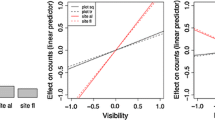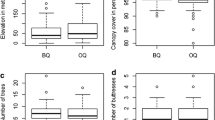Summary
Population units which are homogeneous with respect to capture-recapture assumptions are identified by applying 11 contingency table tests to grasshopper data according to various site, species, growth stage and sex groupings. The results of 2337 contingency table analyses have permitted a definition of the biological, spatial and temporal characteristics of those groupings which were found to be homogeneous. The same analyses suggest that dispersal rates and dispersal patterns pose the greatest single difficulty in defining population homogeneity within an open community. The effects of failures in capture-recapture assumptions are discussed in relation toJolly’s 1965 stochastic model.
A more detailed presentation of the study is available from the author on request.
Similar content being viewed by others
References
Bennett, B. M. andC. Horst (1966)Supplement to tables for testing significance in a 2×2 contingency table. i+28 pp. Cambridge Univ. Press.
Bigelow, R. S. (1967)The grasshoppers (Acrididae) of New Zealand: their taxonomy and distribution. 112 pp+40 plates. Univ. of Canterbury, Christchurch, New Zealand.
Bishop, J. A. andP. M. Sheppard (1973) An evaluation of two capture-recapture models using the technique of computer simulation. pp. 235–252 inThe mathematical theory of the dynamics of biological populations (ed.M. S. Bartlett andR. W. Hiorns), Academic Press, London and New York.
Brussard, P. F. andP. R. Ehrlich (1970) The population structure ofErebia epipsodea (Lepidoptera: Satyrinae)Ecology 51: 119–129.
Carothers, A. D. (1971) An examination and extension of Leslie’s test of equal catchability.Biometrics 27: 615–30.
Carothers, A. D. (1973b) The effects of unequal catchability on Jolly-Seber estimates.Biometrics 29: 79–100.
Carothers, A. D. (1973b) Capture-recapture methods applied to a population with known parameters.J. Anim. Ecol.,42: 125–46.
Cochran, W. G. (1954) Some methods for strengthening the common χ2 tests.Biometrics 10: 417–51
Cormack, R. M. (1964) Estimates of survival from the sighting of marked animals.Biometrika 51: 429–38.
Cormack, R. M. (1966) A test for equal catchability.Biometrics 22: 330–42.
Cormack, R. M. (1968) The statistics of capture-recapture methods.Oceanogr. Mar. Biol. Ann. Rev. 6: 455–506.
Cormack, R. M. (1972) The logic of capture-recapture estimates.Biometrics 28: 337–343.
Eberhardt, L. L. (1969) Population estimates from recapture frequencies.J. Wildl. Mgmt 33: 28–39.
Finney, D. J., R. Latscha, B. M. Bennett, P. Hsu, andE. S. Pearson. (1963)Tables for testing significance in a 2×2 contingency table. vi+103 pp Cambridge Univ. Press.
Fisher, R. A. (1958)Statistical methods for research workers. 13th edition. 356 pp. Oliver & Boyd. Edinburgh.
Gilbert, R. O. (1973) Approximations of the bias in theJolly-Seber capture-recapture model.Biometrics 29: 501–526.
Hudson, L. C. (1970) Identification of the immature stages of New Zealand alpine acridid grasshoppers (Orthoptera).Trans. Roy. Soc. N.Z. (Biol. Sciences) 12: No. 17, 185–208.
Hunter, W. R. andD. C. Grant (1966) Estimates of population density and dispersal in the naticid gastropod,Polinices duplicatus, with a discussion of computational methods.Biol. Bull 131: 292–307.
Inoue, T. K. Kamimura andM. Watanabe (1973) A quantitative analysis of dispersal in a horsefly,Tabanus iyoensis Shiraki and its application to estimate the population size.Res. Popul. Ecol. 14: 209–233.
Iwao, S. (1963) On a method for estimating the rate of population interchange between two areas.Res. Popul. Ecol. 5: 44–50.
Jolly, G. M. (1965). Explicit estimates from capture-recapture data with both death and immigration—stochastic model.Biometrika. 52: 225–47.
Leyton, M. K. (1968) Rapid calculation of exact probabilities for 2×3 contingency tables.Biometrics. 24: 714–717.
Manly, B. F. J. (1970) A simulation study of animal population estimation using the capturerecapture method.J. appl. Ecol. 7: 13–39.
Marten, G. G. (1970) A regression method for mark-recapture estimation of population size with unequal catchability.Ecology. 51: 291–295.
Parr, M. J., T. J. Gaskell andB. J. George (1968) Caputre-recapture methods of estimating animal numbers.J. Biol. Educ. 2: 95–117.
Roff, D. A. (1973) On the accuracy of some mark-recapture estimators.Oecologia. 12: 15–34.
Seber, G. A. F. (1965) A note on the multiple-recapture census.Biometrika. 52: 249–59.
Seber, G. A. F. (1973)The estimation of animal abundance and related parameters. xii+506pp Griffin, London.
Sheppard, P. M. W. W. Macdonald, R. J. Tonn andB. Grab (1969) The dynamics of an adult population ofAedes aegypti in relation to dengue haemorrhagic fever in Bangkok.J. Anim. Ecol. 38: 661–702.
Tanton, M. T. (1969) The estimation and biology of populations of the bank vole (Clethrionomys glareolus (Schr.)) and wood mouse (Apodemus sylvaticus (L.))J. Anim. Ecol. 38: 511–29.
White, E. G. (1970) A self-checking coding technique for mark-recapture studies.Bull. ent. Res. 60: 303–307.
White, E. G. (1971a) A versatile FORTRAN computer program for the capture-recapture stochastic model ofG. M. Jolly.J. Fish. Res. Bd Canada. 28: 443–445.
White, E. G. (1971b)A computer program for capture-recapture studies of animal populations: a FORTRAN listing for the stochastic model of G. M. Jolly.N.Z. Tussock Grassld Mount. Lands Inst. Spec. Pub.8: 33pp+Addendum Pp i–xiii.
White, E. G. (1974a) A quantitative biology of three New Zealand alpine grasshopper species.N.Z.J. Agr. Res. 17: 207–227.
White, E.G. (1974b) Grazing pressures of grasshoppers in an alpine tussock grassland.N.Z. J. Agr. Res. 17: 357–372.
White, E. G. (1975) A “jump net” for capturing grasshoppersN.Z. Entomologist.6.
White, E. G. (in press) A survey and assessment of grasshoppers as herbivores in the South Island alpine tussock grasslands of New Zealand.N. Z. J. Agr. Res. 18.
White, E. G. andR. N. Watson (1972) A food consumption study of three New Zealand alpine grasshopper species.N.Z. J. Agr. Res. 15: 867–877.
Author information
Authors and Affiliations
Rights and permissions
About this article
Cite this article
White, E.G. Identifying population units that comply with capture-recapture assumptions in an open community of alpine grasshoppers. Res Popul Ecol 16, 153–187 (1975). https://doi.org/10.1007/BF02511058
Issue Date:
DOI: https://doi.org/10.1007/BF02511058




